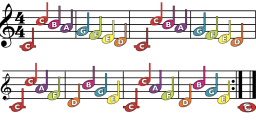Can you identify this melody?
-
searching using musipedia and other search mechanisms with no luck... I think I played this as a child from some piano method.

 Screenshot 2024-09-25 at 12.26.14 PM.png1260 x 606 - 156K
Screenshot 2024-09-25 at 12.26.14 PM.png1260 x 606 - 156K -
This looks like two series of notes in change ringing from a peal of bells. In such change ringing such a series is rung twice and is then followed by a different series. Going through all the permutations of an eight bell peal can take hours - sometimes, depending on the number of bells in the peal, days. It requires great skill and teamwork as each bell is rung by a different person. There are relatively few peals of bells in the US, but in Britain they are quite common. Our Forum member Steve Collins is an authority on bells and English change ringing.
-
Thanks MJO
I knew this was a composition for a bell peal but I was looking for the title -
The first pattern (12345678) is called “Rounds”, and the second (13572468) is called “Queens” in English call-change ringing.
-
I’m curious about the numbers..,
I would match numbers with pitch which would be
187654321
And
186427531
But apparently that is not the logic… why is that? -
1 is the highest pitch not the lowest, because bells always start ringing with the smallest/lightest/highest bell, the treble, and move down to the largest/heaviest/lowest, the tenor. 12345678.
A little by way of background. Your example begins on middle c. It would not do so with actual bells: they would begin rounds with the highest bell, the treble as it’s called, and move down the octave to the lowest, called the tenor. Bells are tuned in a major scale, but there are not always 8 of them (6, 10 or even 12 sometimes, and it also depends how many ringers you have. There are two ways of changing what order the bells are ringing. One is call-changes, where the leader/captain/caller will say, eg “two over three”, so 2 and 3 swap over (3 must ring more quickly for a moment, 2 must hold back to let 3 in, everyone else stays at the same pace), and the new pattern is 132456… you can only do one of those at a time. Here the tenor almost always rings last. The other is method ringing where, briefly, there is pattern which the changes must follow, starting and ending with rounds, and working through a prescribed number of moves. All the bells follow the same pattern but they start at different points on the journey. It can take hours, and in many methods the tenor behaves like any other bell, rather than keeping stroke at the end of the line.
Although bells are tuned according to pitch and scale (a ring of 8 in d-flat, for instance) this is irrelevant to either call-change or method ringing, where it’s the pattern that matters. I lived near a church with an automatic carillon (it worked much like a pianola) which played a variety of tunes, one per day four times a day, provided you didn’t mind that all the notes it could play had to be from a diatonic scale. Not all the tunes it attempted were in fact so composed. -
Thank you @DL… is there a book of scores for this in pdf format? I have chromatic desk bells (as you can see by my colored notation) and I do this with grades 1-8. It would be good to teach them the true art of ringing.
-
I started a search on bell peal scores and ironically this is the first thing that turned up… and it starts with the low C to boot which is exactly the way I put it in my sample above. This is from handbell musicians.
https://handbellmusicians.org/resources/bell-trees/bell_tree_peal.pdf
 E089E31A-DD04-4704-8467-99D8FC00ADFC.png960 x 2079 - 465K
E089E31A-DD04-4704-8467-99D8FC00ADFC.png960 x 2079 - 465K -
@francis
Your original post put me in mind of a Richard Dirksen anthem which I had done with my Episcopal high school choir in 2002-2003. The ending is the "Queens Change" sung on Alleluias by the sopranos and altos over the men singing the initial melody. Very effective, and according to the Richard Dirksen website, the composer's favorite anthem! My students loved it.
https://rwdirksen.com/musical_work/sing-ye-faithful/ -
I also learned this decades ago in my youth. Have used it extensively through my church music career, whenever, and wherever bells of any sort have been available.Thanked by 1francis
Welcome to the MusicaSacra Forum!
To participate in the discussions on Catholic church music, sign in or register as a forum member, The forum is a project of the Church Music Association of America.
Categories
- All Discussions21,057
- General Music Discussion8,195
- Job Openings190
- Management of Music Programs850
- Choral Matters532
- Church Documents and Rubrics524
- CMAA Notes300
- Events713
- For Newcomers: Read First26
- Sacred Polyphony546
- Hymnody871
- Gregorian Chant: General2,694
- ↳ Graduale Romanum and Liber Usualis367
- ↳ Graduale Simplex60
- ↳ Semiology63
- Vernacular Plainsong695
- Anglican Use and Anglican Chant69
- Organ, Other Instruments and Repertoire434
- New Composition/Works in Progress1,286
- Recordings229
- Music for Hispanic Ministry159
- Music Education: Children211
- Music Education: General222
- News Items245
- Positions Wanted2
- General Discussion: Catholicism738
- Amusements176
- General Discussion1,033
- Opinions117

